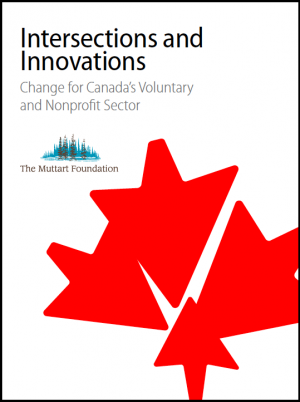This is an excerpt from Chapter 9 of “Intersections and Innovations: Change for Canada’s Voluntary and Nonprofit Sector,” edited by Susan Phillips and Bob Wyatt and published as a free e-book by the Muttart Foundation.
Chapter 9: Financing Canadian Charities: The Conditional Benefits of Revenue Diversification
By Nathan J. Grasse and Marcus Lam
In general, Canadian charities are financed through a variety of revenue streams that include individual and corporate donations, government contracts, foundation grants, memberships, and a growing array of commercial activities. This funding is increasingly volatile, and many charities feel financially vulnerable in both the short- and long-term for good reason…
The advice that is overwhelmingly given to nonprofits on how to survive and thrive in such an unstable financing environment is to diversify their sources of revenue. This strategy of diversifying funding makes intuitive sense and has become accepted wisdom among the multitude of consultants and financial advisors to nonprofits. It seems logical that overreliance on any one revenue stream is to be avoided because it can potentially expose nonprofits to financial instability if the funding source is reduced or eliminated. The academic research, however, does not unequivocally support diversification as the best strategy. A number of studies have found positive relationships between funding diversity and financial stability. Yet recent studies point to evidence against revenue
diversification and in support of revenue concentration, demonstrating that organizations with concentrated revenue portfolios have increased capacity…
 This chapter takes a closer look at the revenue streams of Canada’s charitable sector, with a view to better understanding the pros and cons of financial diversification. Do increasing degrees of diversification produce increasingly better financial health? For which kinds of charities does diversification seem to produce greater long-term viability? We first provide an overview of the mix of revenue sources for Canada’s charitable sector and review the theories that aim to explain the benefits of diversified revenue portfolios. These theories and the ways in which they have been applied have significant limitations, however. In general, existing research has been limited to linear associations between revenue diversity and organizations’ financial conditions; that is, they assume that as revenue diversity increases, there will be a proportionate effect on financial stability and health. In practice, however, this relationship may be nonlinear, and, in fact, diversity may exhibit diminishing returns on financial health at a certain point. In this chapter, we argue for a more sophisticated approach to understanding the effects of funding diversification and test the potential for Canadian charities of a nonlinear relationship of diversity and financial health.
This chapter takes a closer look at the revenue streams of Canada’s charitable sector, with a view to better understanding the pros and cons of financial diversification. Do increasing degrees of diversification produce increasingly better financial health? For which kinds of charities does diversification seem to produce greater long-term viability? We first provide an overview of the mix of revenue sources for Canada’s charitable sector and review the theories that aim to explain the benefits of diversified revenue portfolios. These theories and the ways in which they have been applied have significant limitations, however. In general, existing research has been limited to linear associations between revenue diversity and organizations’ financial conditions; that is, they assume that as revenue diversity increases, there will be a proportionate effect on financial stability and health. In practice, however, this relationship may be nonlinear, and, in fact, diversity may exhibit diminishing returns on financial health at a certain point. In this chapter, we argue for a more sophisticated approach to understanding the effects of funding diversification and test the potential for Canadian charities of a nonlinear relationship of diversity and financial health.
The full chapter is available at muttart.org/resource-library.
Nathan J. Grasse is an editor of PANL Perspectives and an assistant professor in the MPNL program at Carleton University. Marcus Lam is an assistant professor in the Department of Leadership Studies at the University of San Diego.
Monday, June 21, 2021 in Fundraising, Intersections & Innovations, Social Finance
Share: Twitter, Facebook



